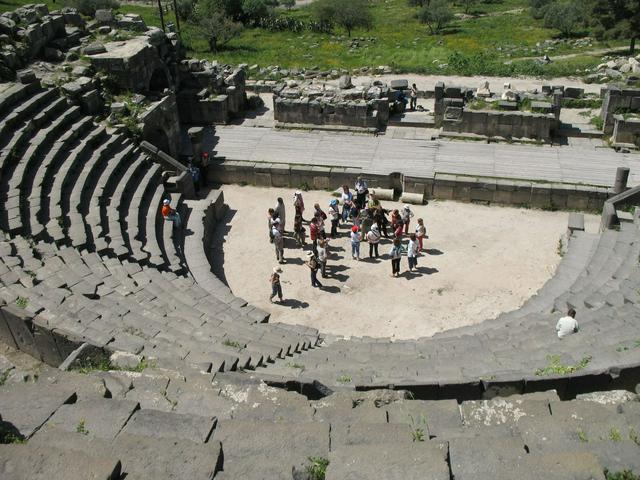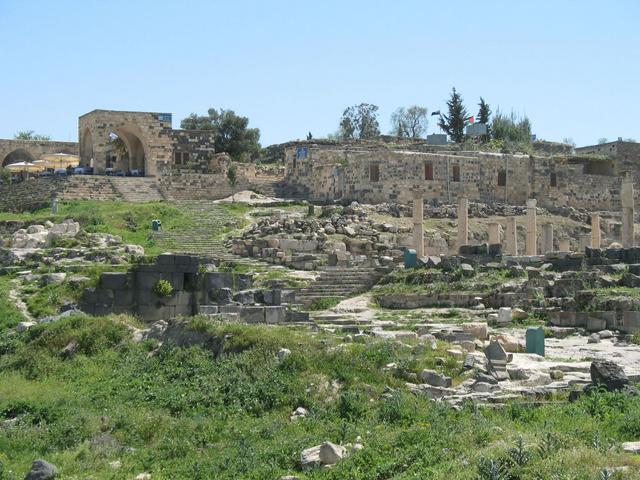Umm Qais is a Roman ruin in Northern Jordan.
Umm Qais was once the Decapolis city of Gadara. Although not as extensive as Jerash, the ruins cover periods from Roman rule to the Ottomans and provide sweeping views over the Sea of Galilee and the Golan Heights, and a peaceful experience.
The city remained unrecognised for about 1000 years and only in the 19th century became alive again.


- Umm Qais ruins, +962 7 9671 6796. 08:00-19:00. Site of the famous miracle of the Gadarene swine, Gadara was renowned in its time as a cultural centre. The ruins include a theatre, a colonnaded street, Roman shops, temples and houses, and a large Ottoman village that includes a museum. 3 JD (free with Jordan Pass; guides are available from 10 JD for a 40-min tour, and some basic brochures are available.
* Um Qais Museum.
* The main road. Includes the tombs and black basalt pillars.
* The theater. Made of black basalt as well and is markable for some of the seats having a back rest.
* Basilica remains. The remains of a five reedy basilica and an octagonal chapel.
* City ruins. A road with former shops above the basilica, apparently including a quite good restaurant.
* Pillar path. Leading to the rest of an old doorway.
You might also want to take a look at the almost 2000-year-old houses that where still inhabited just a few years ago.
In addition, the convenient location offers great views of the surrounding area, including the Israeli side:
- Yarmuk river. Just north, behind which the Golan Heights are located.
- Sea of Galilee. To the northwest and part of the Sea of Galilee region.
- Mount Tabor. This mount to the west with the impressive and beautiful Church of Transfiguration.
Umm Qais ruins, +962 7 9671 6796. 08:00-19:00. Site of the famous miracle of the Gadarene swine, Gadara was renowned in its time as a cultural centre. The ruins include a theatre, a colonnaded street, Roman shops, temples and houses, and a large Ottoman village that includes a museum. 3 JD (free with Jordan Pass; guides are available from 10 JD for a 40-min tour, and some basic brochures are available.
* Um Qais Museum.
* The main road. Includes the tombs and black basalt pillars.
* The theater. Made of black basalt as well and is markable for some of the seats having a back rest.
* Basilica remains. The remains of a five reedy basilica and an octagonal chapel.
* City ruins. A road with former shops above the basilica, apparently including a quite good restaurant.
* Pillar path. Leading to the rest of an old doorway.
Yarmuk river. Just north, behind which the [[Golan Heights]] are located.
Sea of Galilee. To the northwest and part of the [[Sea of Galilee region]].
Mount Tabor. [[Tiberias#Go_next|This mount]] to the west with the impressive and beautiful Church of Transfiguration.
Hiking around in the area and enjoying the beautiful views is pretty much the only thing to do here.
Flowers are sold in spring when everything is blooming by some of the local people. Buy some and support the local community.
- Umm Qais Rest House, Hizam Ring Rd (in the Umm Qais ruins, +962 7 9202 7610. 12:00-01:00. The Umm Qais Rest House is built in an Ottoman school on the site. The food is not cheap but is very good and the terrace has sweeping views over the valleys (including the Golan Heights and the site itself). 5-20 JD.
Umm Qais Rest House, Hizam Ring Rd (in the Umm Qais ruins, +962 7 9202 7610. 12:00-01:00. The Umm Qais Rest House is built in an Ottoman school on the site. The food is not cheap but is very good and the terrace has sweeping views over the valleys (including the Golan Heights and the site itself). 5-20 JD.
- Al-Himma – therapeutic hot springs located 10 km north. Once highly regarded by the Romans, two bathing facilities: a privately-run and a public one. Note, there are separate timetables for men and women.
- Irbid – The main industrial and administrative centre in the north of the kingdom.
- Pella – Ancient ruins.
Al-Himma – therapeutic hot springs located 10 km north. Once highly regarded by the Romans, two bathing facilities: a privately-run and a public one. Note, there are separate timetables for men and women.
